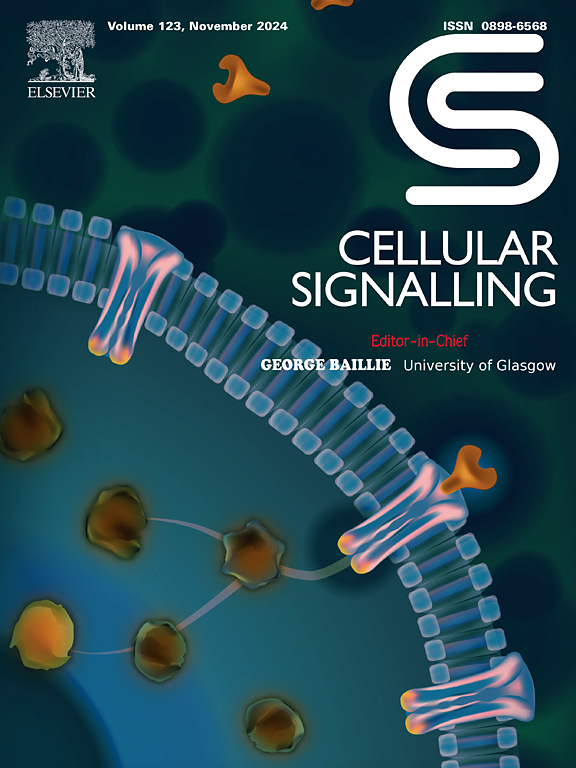Hypoxia ameliorates high-fat-diet-induced hepatic lipid accumulation by modulating the HIF2α/PP4C signaling
IF 4.4
2区 生物学
Q2 CELL BIOLOGY
引用次数: 0
Abstract
Hepatic lipid accumulation is a hallmark of metabolically associated fatty liver disease (MAFLD), which contributes to the progression of cirrhosis and even hepatoma. However, the underlying mechanisms remain poorly understood. Protein phosphatase 4C (PP4C) is an important enzyme that exists widely in the body and participates in cell metabolism. Hypoxia can affect the development of metabolic diseases. In this study, we investigated the role of PP4C in hepatic lipid metabolism under hypoxia in vivo and in vitro. Hypoxia-inducible factor 2α (HIF2α), PP4C, phosphorylated AU-rich element RNA-binding factor 1(pAUF1), acetyl-CoA carboxylase 1 (ACC1), and carnitine palmitoyl transferase-1 (CPT1) were analyzed via western blotting and immunofluorescence. The mechanism by which PP4C affects hepatic lipid accumulation under hypoxia was evaluated in stable transfected cell lines. Compared with those in the 2200 m HFD group, body weight, triglyceride (TG), total cholesterol (TC), amino alanine transferase (ALT), aspartate transaminase (AST), and lipid accumulation were lower in the 4500 m HFD group (P < 0.05). Compared with those in the 4500 m ND group, ACC1 and PP4C levels were lower than in the 4500 m HFD group, but HIF2α, pAUF1, and CPT1 levels were greater (P < 0.05). Knockdown of HIF2α prevented the hypoxia-induced reduction of PP4C, confirming the regulatory role of the HIF2α-PP4C axis in hepatic lipid metabolism. PP4C could affect the phosphorylation and expression localization of AU-rich element RNA-binding factor 1 (AUF1). PP4C enhanced lipid accumulation by reducing pAUF1, while the knockdown of PP4C had the opposite effect; pAUF1 had no change. Compared with those in the control group, ACC1 levels were decreased and CPT1 levels were increased in the AUF1 overexpression group, whereas ACC1 and CPT1 levels were not altered in the AUF1 knockdown group (P < 0.05). In conclusion, hypoxia might improve lipid accumulation by downregulating PP4C via HIF2a. PP4C is involved in hepatic lipid metabolism by regulating AUF1 phosphorylation under different oxygen concentrations. PP4C might be a promising target for treating hepatic lipid accumulation.
缺氧通过调节 HIF2α/PP4C 信号转导改善高脂饮食诱导的肝脏脂质积累
肝脏脂质积累是代谢性脂肪性肝病(MAFLD)的一个标志,它有助于肝硬化甚至肝癌的进展。然而,潜在的机制仍然知之甚少。蛋白磷酸酶4C (Protein phosphatase 4C, PP4C)是广泛存在于体内并参与细胞代谢的重要酶。缺氧可影响代谢性疾病的发展。在本研究中,我们研究了PP4C在体内和体外缺氧条件下肝脏脂质代谢中的作用。western blotting和免疫荧光分析缺氧诱导因子2α (HIF2α)、PP4C、磷酸化富au元素rna结合因子1(pAUF1)、乙酰辅酶a羧化酶1(ACC1)、肉毒碱棕榈酰转移酶1(CPT1)。在稳定转染的细胞系中评估了PP4C影响缺氧条件下肝脏脂质积累的机制。与2200 m HFD组相比,4500 m HFD组体重、甘油三酯(TG)、总胆固醇(TC)、氨基丙氨酸转移酶(ALT)、天冬氨酸转氨酶(AST)和脂质积累均较低(P < 0.05)
本文章由计算机程序翻译,如有差异,请以英文原文为准。
求助全文
约1分钟内获得全文
求助全文
来源期刊

Cellular signalling
生物-细胞生物学
CiteScore
8.40
自引率
0.00%
发文量
250
审稿时长
27 days
期刊介绍:
Cellular Signalling publishes original research describing fundamental and clinical findings on the mechanisms, actions and structural components of cellular signalling systems in vitro and in vivo.
Cellular Signalling aims at full length research papers defining signalling systems ranging from microorganisms to cells, tissues and higher organisms.
 求助内容:
求助内容: 应助结果提醒方式:
应助结果提醒方式:


